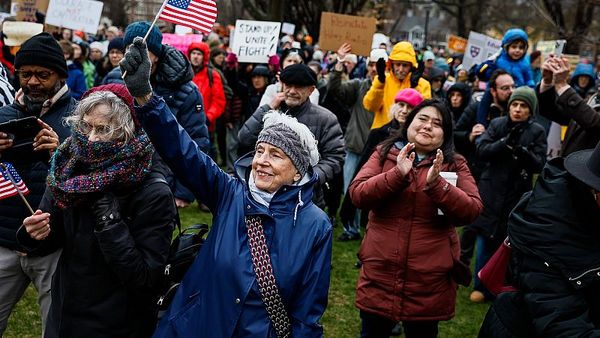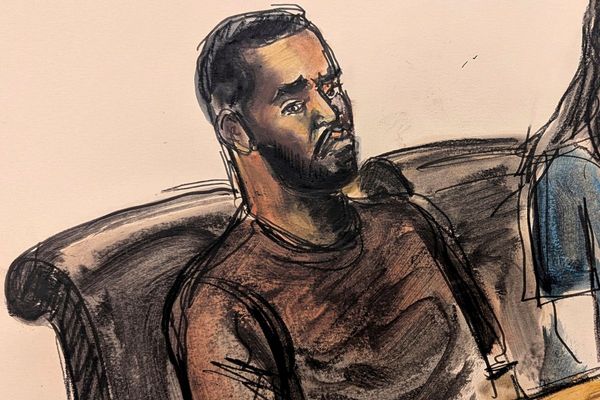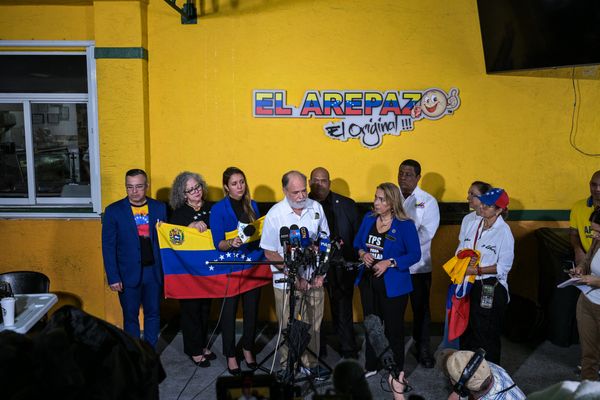
One Saturday last October, between the skyscrapers of São Paulo’s main avenue, surrounded by thousands turned out for yet another protest against Brazil’s far right president, a hog danced with a leopard.
They were joined by a six-legged beetle, a parrot, a pink dolphin and over a dozen other people in similarly elaborate animal costumes, each brandishing banners proclaiming, in Portuguese, gnomic phrases such as “Cosmic Dancer”, “Defend Happiness” and “Gaia’s Return”. Some danced, others blew bubbles or burned incense.

A few weeks later, at another protest, this time smaller and organised by the homeless movement, this strange menagerie was present again. They were, they told me, the Crystal Forest. Further investigation revealed that the strange theatrical group, which appeared at eight protests and demonstrations around the city, was founded by artist Rivane Neuenschwander and film-maker Mariana Lacerda.
Sat in Neuenschwander’s studio in the west of São Paulo, the costumes and masks piled up on a table, the protest banners with their strange proclamations stacked to the side, the artist explains, “We had the idea of interfering with the demonstrations. We were interested in changing the language of the left in protests, because they are always articulated in the same way, with the same social grammar.”
Working together, the pair made I Am a Macaw, a new 30-minute film that documents this year of interventions, and which will be premiered in Porto, Portugal, as Brazil goes to the polls in the presidential election this Sunday. In 2018, the sizeable Brazilian expat community in Portugal overwhelmingly supported Jair Bolsonaro, now fighting for a second term.
The film is a devastating and mournful document of the country’s left wing at the end of its tether. Mixing with the environmental sounds of protest – shouts and chants, political speeches – is a strange instrumental soundtrack by O Grivo, a duo of musicians from Belo Horizonte. Screeching violins break against booming gongs and clanging glockenspiels; São Paulo’s streets seem eerie, for all the people and political activity depicted.
“We didn’t know what to expect,” Neuenschwander says. “At the first protest it caused a stir and seemed a big success. We attended between seven to eight protests, with up to 50 people in costume. We want to contaminate the street, with the utopian idea that maybe everyone will come dressed up in the end.
“When Dom and Bruno were murdered there was a demonstration organised on a Saturday morning at Masp,” Neuenschwander recalls, referring to Bruno Pereira, the former Amazon protection officer murdered alongside British journalist Dom Phillips in June. “It was a small gathering, just a group of Guarani people present. It was raining, it was special.” In the film, mingling outside São Paulo’s biggest art museum, the Indigenous protesters chant and paint each other’s faces with ceremonial markings.

The work finds precedent in previous projects by Neuenschwander. In 2015 she collaborated with groups of London schoolchildren to present a series of intricately designed capes, shown at the Whitechapel Gallery, representing each child’s greatest fear. Conversely I Wish Your Wish (2003) mimicked Brazilian pilgrimage sites by displaying thousands of ribbons printed with visitors’ greatest wishes.
The artist says the immediate impetus for I Am a Macaw came amid a court battle against a rule that only land occupied by Indigenous groups on the date the Brazilian constitution was signed in 1988 could be the subject of protection. Yet it is not just this specific scandal they are fighting, as urgent as it is, but rather arguing for a fundamental resetting of humanity’s relationship with the natural world. Many of their protest banners suggest as much: “Legal animism”, “insurgent corals”, “the future is ancestral”.
“We wanted to push the discussion of the rights of nature, which happens in Ecuador and was in the proposed constitution of Chile, but which people aren’t really discussing in mainstream Brazil,” she says.
In 2008 Ecuador was the first country in the world to enshrine personhood on natural entities such as rivers and mountains. In doing so it recognised the unique relationship between Indigenous communities and their environment, in which land is often entwined in spiritual beliefs and therefore protected.
In Lacerda’s film, we see Neuenschwander’s animals away from protests, individually handing out leaflets in downtown São Paulo or flyposting the city’s walls. Some show images of devastating arson attacks on the rainforest or Indigenous villages under assault, others detail lines from the Ecuadorian constitution: “Nature has the right to full respect for its existence” reads one poster, another says “Nature has the right to be restored”.
“We are trying to bring a richer vocabulary to the protests, away from the usual buzzwords of the left,” Neuenschwander says. “There is a philosopher from Rio called António Carvalho who spoke of bringing enchantment to the streets, and we listened to Indigenous leaders like Davi Kopenawa Yanomami and ideas of decolonialism and how everything is interconnected.”
In a 2016 paper Carvalho writes of suspending “the modern dualism between body and mind, nature and culture, human and non-human. Recognising that the impetus of modernity is essentially extractive.”
Does Neuenschwander still believe in the power of protest, though? In 2013 Brazil experienced era-defining demonstrations against the country’s myriad injustices, which some argue unintentionally created the environment for leftwing president Dilma Roussef’s 2016 impeachment and today’s far-right government.

“I still see protest as a positive thing,” Neuenschwander says. “There’s a lot of discussion of what happened in 2013 and how 2016 came about, how that energy got manipulated, how the right wing captured the energy. The film is pretty melancholic, yes; a reflection of how melancholic Brazil has been, a reflection of going to so many demonstrations.”
She concludes: “As Bolsonaro destroyed everything, we suffered mentally. I suffered, my friends suffered. We got depressed, so this film was a way of getting together too, dressing up, having a beer. The film reflects those highs and lows: of feeling so down, but then also waking up the next day and thinking, ‘Let’s fight again!’”







